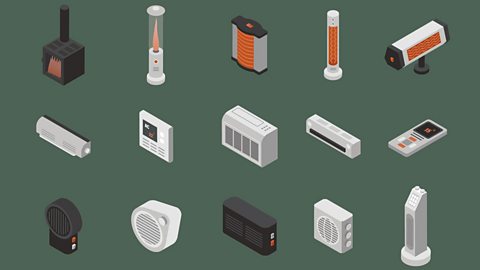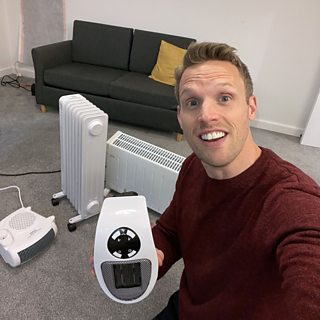What's the best way to heat a room this winter?
Sliced Bread is back to see if more wonder products that claim to make us healthier, happier and greener really stand up to scrutiny.
In this episode, Greg Foot gets cosy with different kinds of portable home heating options – or space heaters – to work out the best way to heat a room. The results are really rather eye-opening.
Greg's challenge is set by listener Ken from Aberdeen. Helping him on his mission for energy efficiency are Octopus Energy 'Future Technologies Evangelist' Phil Steele and Energy Saving Trust knowledge manager Joanna O'Loan. Here's what you need to know if you're thinking of buying your own portable heater to chase away those winter chills.
1. There are a variety of heater types available
Ken put Greg on the trail of ceramic heaters, one example of which claims to use 30% less energy than other heater types. Greg decides he will also test a range of typical, 'OG' models alongside it: a freestanding convector heater, a freestanding oil-filled radiator and a small fan heater.
2. These heaters all work slightly differently
The hand-sized ceramic heater has a small fan to blow out the heat generated in the ceramic fixture (inside of which is likely to be an electrical element). With the freestanding convector heater, filaments inside are heated up and they, in turn, heat up the air, which rises up into the room. The small fan heater is a mini version of the convector heater but with a fan to push out hot air and give an instant impact. Finally, with the oil-filled radiator the convection current is, in effect, inside. The oil warms up, rises and, as Phil describes, "heats the air next to it and then the air next to that." It's impact is initially less marked than the other models.

3. Not every heater consumes the same amount of energy
A device's power is measured in Watts (or thousands of Watts called Kilowatts). The amount of electrical energy they use is measured in Kilowatt Hours. The ceramic fan heater is the smallest consumer of electrical power at 500W. At the Electricity Price Guarantee Cap of 34p per kWh, if it was on for an hour that would cost 17p. The free-standing oil-filled radiator is rated at 1,500W but drops to 600W after 10 minutes when all the oil is heated. The small fan heater and the freestanding convector heater are both rated at 2,000W so if they were on for an hour they would cost 68p.
Heating a room to a tolerable level would cost a similar amount whichever portable heater is used.
On the face of it, the ceramic heater is cheaper, using one-fifth of the energy of the convector heater or the small fan heater. However, it is also producing one-fifth of the heat.
4. It costs the same to maintain heat in a room no matter what heater is used
The rule of thumb is that higher wattage heaters will heat a room more quickly (as they output more heat) but will cost more for every minute they are on. Lower wattage heaters will take longer to heat a room but will cost less for every minute they're on.
This means that producing a certain amount of heat energy over time and heating a room to a tolerable level (18 degrees is the World Health Organisation's definition of a 'comfortable heat') would cost a similar amount whichever portable heater is used. It's just that each heater would take a different amount of time to do it.

Is it cheaper to heat yourself or the room that you're in?
Greg shares his surprising portable heater findings with listener Ken.
5. Some heaters can encourage you to turn up the temperature
Though tests resulted in a dead heat between models, there are some nuances.

In most cases, the cheapest option would be to heat the room using your gas boiler and radiators.
Ultimately, Phil feels that the most benign heater – the oil heater – is the preferred model for heating up a room rather than the other models, which are either blowing out hot air or, in the case of the convector heater, producing a gentle flow of hot air. He explains that this is because "when the thermostat kicks in and the heater stops, you immediately start to feel a little bit cooler, so what you tend to do is to get back to it and tap it up a little bit..." This 'addiction' will, of course, end up costing you more money.
However, if you want a focused blast of heat while sitting in a room for a while then the ceramic heater (albeit with the ceramic surface becoming alarmingly hot) and the fan heater would be the cheapest and quickest options respectively.
6. For longer term heating, it's usually cheaper to turn on the heating
Rather than use a space heater, it might actually be better to heat your whole house.
Energy Saving Trust knowledge manager Joanna O'Loan explains the line between using free-standing portable systems or central heating:
"If it was only for an hour or so and you had a particularly large room that only needed heating in a small corner where your desk is, the plug-in heater might be the cheaper option. However, in most cases, the cheapest option would be to heat the room using your gas boiler and control with your thermostatic radiator valves. This is because gas is around three times cheaper than electricity per unit."
7. A heated vest and infra-red are two unusual heater alternatives
Greg mentions some novel alternatives to space heaters, raised by listeners (including Greg's dad!).
One is a battery-operated, heated gilet-like vest with electricity running to patches on the chest and on either side of it. Phil says that 'heating the person and not the room', as Greg puts it, is "probably a good solution". He cites the popularity of electric blankets, which only consume around 100 watts compared to 2,000 watts for some of the space heater models.
Another heating solution that focuses on the person and not the room is infra-red. Fitted under wallpaper or carpet, the system works via a pair of copper strips with a graphene layer in the middle that emits infra-red when the voltage is put through the copper strips. The infra-red is rated at just 200 watts, less than the ceramic heater but with a lot more set-up involved.
Find out more about Greg's investigations into portable heaters and how listener Ken responded to his findings here.
The information contained in this article was correct at the time of broadcast on 10 November, 2022.

More articles from Radio 4
-

How did e-cigarettes and vaping get so popular?
Tracing the history and extraordinary growth of e-cigarettes.
-

Is an electric toothbrush the best way to clean your teeth?
Greg takes to the dentist's chair and tests brushes from the big brands, seeking advice from a dental expert.
-

Electric cars: Eight things you need to know
Will swapping your petrol car for a new electric vehicle make you greener?
-

Why we should all be taking cold showers
Dr Michael Mosley takes a chilly dive into the science of cold water to find out how it could help your mood, brain, immune system and heart.

